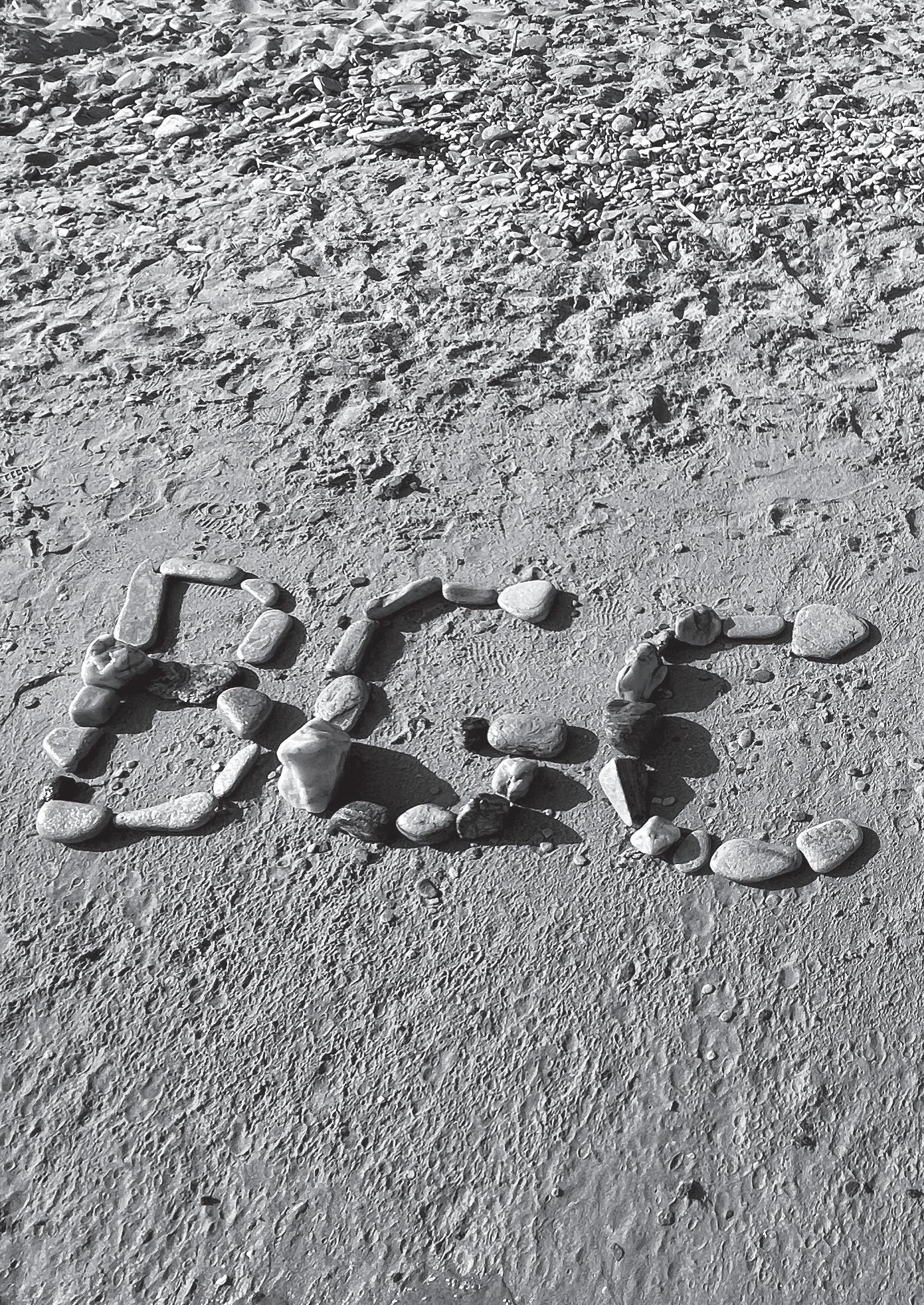
8 minute read
Student Travel and Research
This Page: Photo courtesy of Emily Harvey.
Right: Juliana Fagua-Arias. Photo by Fresco Arts Team.
Advertisement
Juliana Fagua Arias (MA ’21)
In November 2020, I took an online cochineal-dyeing workshop with Zapotec master weaver Porfirio Gutierrez. Over the course of two days, we learned the process of dyeing with cochineal, from grinding the dried insects to washing the dyed fabric. All materials were provided by the workshop organizers, Botanical Colors, including two pieces of premordanted fabrics (treated to receive dye) and the cochineal insects. The workshop was taught by Gutierrez, who kindly supervised, answered questions, and advised every participant individually. He demonstrated each step using two cameras, one showing himself in his workshop and the other showing a close-up of his hands and process.
As Gutierrez provided instructions, he also gave us technical and chemical explanations of the materials and techniques we were employing, such as why cochineal reacts differently depending on the fabric. Teaching the class from his workshop in Ventura, California, he also gave a tour of his studio, presenting his most recent creations. He explained the dyeing and weaving process for each piece and the materials, tools, and technologies employed.
Gutierrez prepared lectures that situated cochineal dye in a historical and cultural context. He spoke about cochineal as a species, its cultivation and harvest in Mexico, the different uses of cochineal-dyed fabrics in the Zapotec culture, and the symbolism associated with the bright red color. He complemented this historical approach with contemporary photographs of ceremonies where cochineal-dyed fabrics play an important role. For each session, we received a document with important notes and information and a link to the recording to consult as many times as we wanted in the future.
Despite the usual difficulties of remote classes, the fact that this was an online workshop granted me access to it; had it been in-person, the time and financial commitment would have been too much for me on top of my academic responsibilities. It provided me with a sensorial and physical understanding of the dye material, complemented my historical knowledge, and introduced me to a network of weavers, natural dyers, and artists from all over the world who also taught me a lot during the workshop. I am grateful for the support of the Bard Graduate Center, which covered workshop expenses through the student travel and research fund. I encourage all students to consider online material workshops in the future.
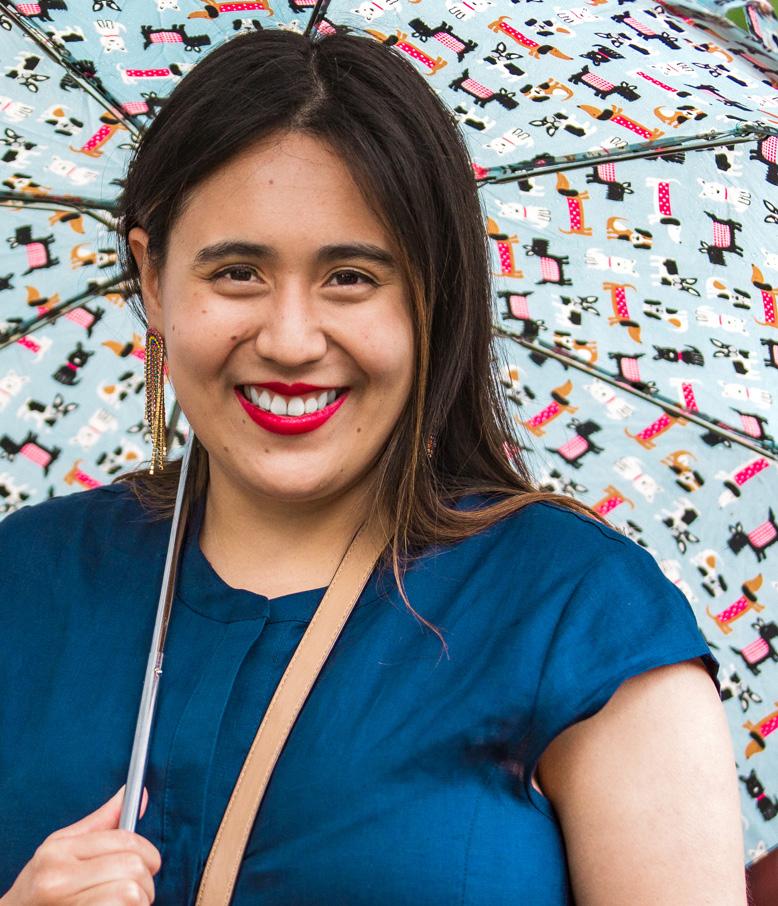
Emily Harvey (MA ’23)
Directly after finals week, the first-year MA students spent twenty days in Paris and Greece. In Paris, we were hosted by the École du Louvre and learned about eighteenth- and nineteenth-century decorative arts, interspersed with modern art and fashion. And in Greece, we explored Greek heritage while working on an archaeological project on the island of Despotiko. Here is my travelogue.
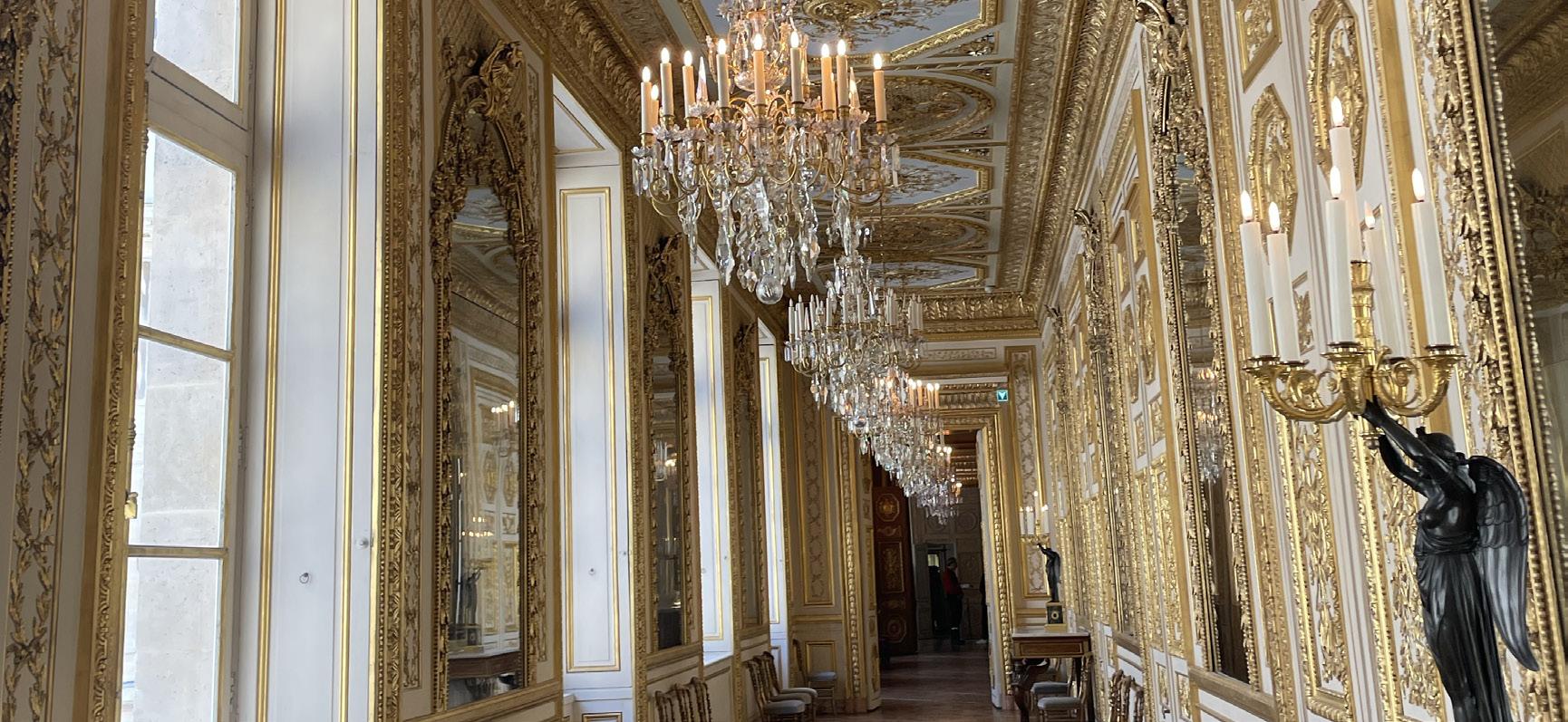
Monday, May 9:
On our first day in Paris, we walked through the Palais Royale in the early morning. Later that day, we were introduced to many faculty members of the École du Louvre.
Tuesday, May 10:
Having overcome our jetlag, we made our first venture into Parisian museums. We started the day with a history of Paris at Musée Carnavalet with the curator of decorative arts, Ulysse Jardat. We then ventured outside of Paris to Écouen, where we hiked through a beautiful park to reach the Musée national de la Renaissance. Curator Julie Rohou gave us a tour and presented and dismantled the Daphne Cup, an object in a case study we had encountered through the “Objects in Context” course.
Left: The interior of the newly reopened Hôtel de la Marine. Photo courtesy of Emily Harvey.
Right: One of several interior courtyards of the Louvre. Photo courtesy of Emily Harvey.
Wednesday, May 11:
This day was all about eighteenth- and nineteenth-century decorative arts! It began at the Louvre with a special tour of the Napoleon III Apartments that focused on the power of extravagance in the political world. After a lunch break, we made our way to Musée Nissim de Camondo, an outpost of the Musée des Arts Décoratifs, to learn about its collection of eighteenth-century decorative objects.
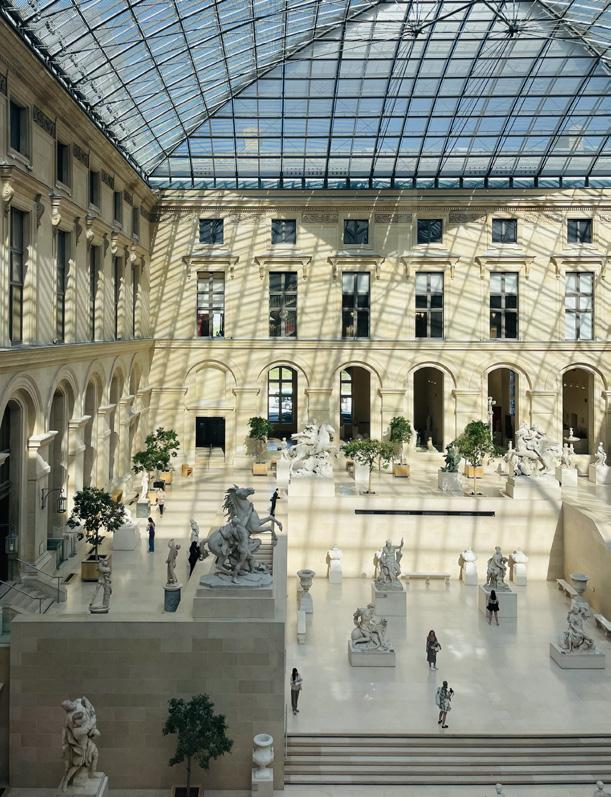
Thursday, May 12:
On our fourth day in Paris, we traveled to Musée d’Orsay to learn about the decorative arts of the art nouveau period. For many of us, the day’s highlight was the trip to the Palais Galliera, Paris’s fashion museum. Curators Alexandre Samson and Laurent Cotta guided us through all periods of Parisian fashion, including supreme examples of eighteenth- and nineteenth-century dress and modern-day haute couture.
Friday, May 13:
After a morning at Fondation Le Corbusier, we crossed the Seine for a special tour of the Sèvres—Manufacture et Musées nationaux with its director, Dr. Charlotte Vignon. She led us through the production workshops, including those of the mold makers and the ceramic painters. Afterward, we were given a brief tour of the museum and its renovation plans.
Saturday, May 14, and Sunday, May 15:
With no set agenda for the weekend, one of my classmates and I spent Saturday exploring museums including the Hôtel de la Marine and Musée de l’Orangerie. The most exciting part of the weekend was a short trip to Giverny, the home and studio of Claude Monet. The gardens were full of irises and other flowers in full bloom, allowing us a break from the city.
Monday, May 16:
The highlight of the trip, at least for me, came on Monday with not one but two special tours of the palace of Versailles. These two tours were led by Sophie Mouquin, a professor and specialist in the marbles of Versailles,
BGC students in Despotiko, Greece. Photo by Caspar Meyer.
and Marie-Laure de Rochebrune, the chief curator, who showed us the King’s Apartment. As Versailles was closed to the public, we were able to see the palace empty and quiet for the better part of the day. While many areas on the grounds were closed for filming, we explored the gardens and enjoyed a nice picnic!
Tuesday, May 17:
Our final day in Paris brought us to the Hôtel de la Païva, built by a famous nineteenth-century courtesan and now the location of an elite travelers’ club. In the afternoon, we wrapped up the trip with a visit to the newly reopened Musée de Cluny, where we met with the curator Béatrice de Chancel-Bardelot.
Thursday, May 19:
After traveling to Greece, we spent two full days in Athens, learning all we could about Greek culture and seeing some of the most famous historical sites in the world. We started the day with a very windy trip to the Acropolis and its sister museum with professor Caspar Meyer, and we ended it with a wonderful trip to the Benaki Museum led by Dr. George Manginis.
Friday, May 20:
On our final day in Athens, we traveled to two museums that played a key part in our understanding of the archaeological project we would soon take part in. The first was the Museum of Cycladic Art, where we were led by Dr. Ioannis Fappas. The second was the National Archaeological Museum, where we learned about the types of objects found on archaeological sites around Greece and the importance of these objects in understanding ancient Greek culture.
Saturday, May 21:
This was another travel day for us, but instead of a plane, we took a fourhour ferry ride to the island of Paros, followed by another short ferry ride to Antiparos, where we stayed for the next seven days.
Sunday, May 22:
On Sunday, we were guided through the Paros Archaeological Museum, where the majority of objects and fragments found on Despotiko are
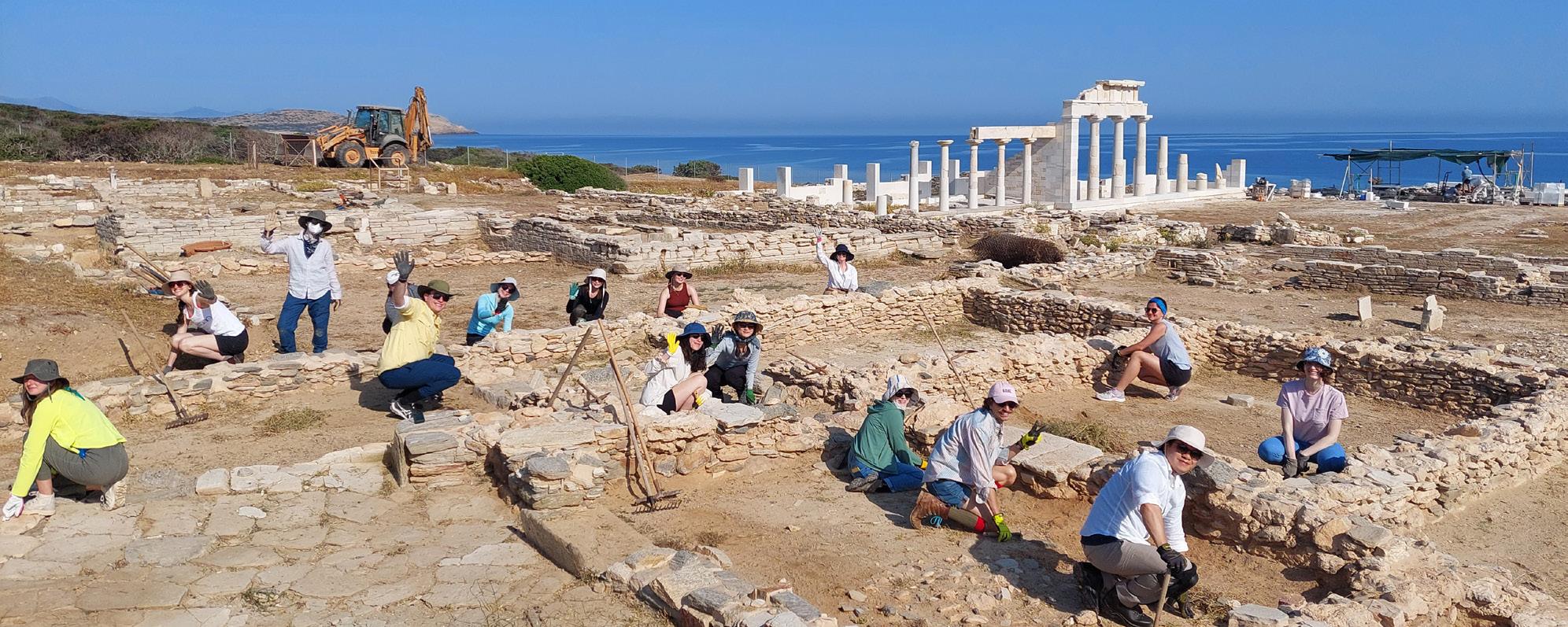
stored. We learned about the conservation of archaeological objects along with the history of marble and ceramics on the islands of Paros, Antiparos, and Despotiko.
Monday, May 23–Friday, May 27:
During this week, we spent the majority of our mornings and afternoons traveling to and digging on the island of Despotiko. Some of our tasks included clearing weeds and surface dirt, digging new areas of excavation, excavating established rooms in the complex, and cleaning the ceramic fragments before their transfer to Paros.
While it was hot and we were all covered in dirt by the end of each day, many of us found that by working directly on an archaeological site, we had a better understanding of and appreciation for the objects we were handling.
As a special ending to the trip, we spent Friday afternoon on a small beach where we enjoyed a nice lunch and a swim. We also got a quick boat tour of both Despotiko and Antiparos, where we jumped into the sea and explored the interesting rock formations!
Saturday, May 28–Sunday, May 29:
Sadly our trip had to end, and we found ourselves back in Athens for one night before heading back to New York.
For many of us, the trip went by far too quickly, but we are all incredibly grateful for the time and effort put in by everyone at Bard Graduate Center, the École du Louvre, and the Despotiko archaeological dig for making this trip possible for us. I would like to especially thank professors Jeffrey Collins and Caspar Meyer for leading us on this adventure, PhD candidate and teaching assistant Elizabeth Koehn for making Paris so fun, and École du Louvre representative Lea Marchal for putting together an amazing itinerary in Paris.










